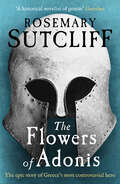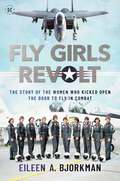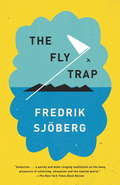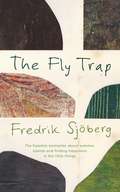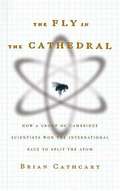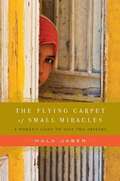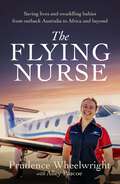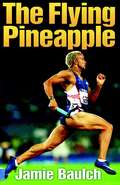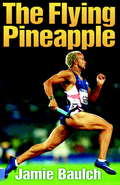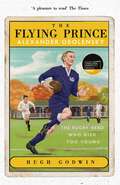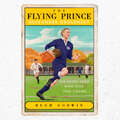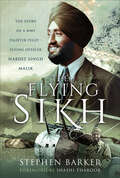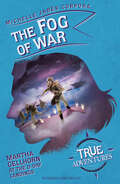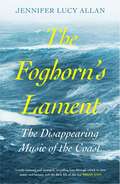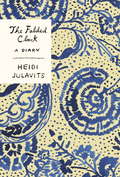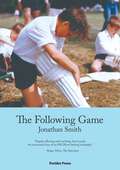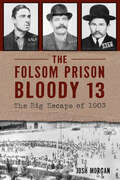- Table View
- List View
The Flowers of Adonis
by Rosemary SutcliffA &“highly satisfactory&” historical novel portrays Alcibiades as &“magnetic, brilliant, often ruthless, restless, unable to accept a simple destiny&” (Kirkus Reviews). From the internationally acclaimed author of The Eagle of the Ninth . . . The epic story of Greece&’s most controversial hero. In the fifth century BC, against the background of perpetually warring Greek city-states, one man towered above the chaos. His name was Alkibiades. Friend of Socrates, sailor, warrior and incorrigible lover, he fled persecution in his native Athens to join her enemy: Sparta. However, his brilliant naval and diplomatic victories could not save him from the consequences of impregnating the Spartan queen, and once more he was forced to flee. Alkibiades settled into life as a roving soldier of fortune, though his love for Athens proved to be the overriding influence of his later life. When that glorious city eventually fell to the Spartans, his own violent demise was shortly to follow . . . &“A fascinating character study told with skill and erudition.&” —The Daily Telegraph &“A gripping story of battle, intrigue and ruin.&” —Evening Standard
The Fly By Nights: RAF Bomber Command Sorties 1944–45
by Donald W. FeeseyAt the age of eighteen Don Feesey volunteered for pilot training with the RAF. Having almost completed his course to become a fighter pilot, an eye problem was detected and he was switched to navigational training. He completed a tour of thirty-four successful operations, the majority at night during 1944 and 1945 at the height of the bomber offensive. On one remarkable sortie his Lancaster lost all power and the order to bale out was given. As the aircraft gradually lost altitude, making a safe parachute descent more impossible by the second, Don was about to jump when the pilot, still at the controls, attracted his attention. It was a life or death situation. Should he jump or go to the assistance of his pilot, leading to an almost certain death? He elected to go to the aid of what he thought was his trapped pilot but to his astonishment he found that the skipper had nursed one engine back into life, so the only two remaining crew managed to struggle back across the Channel, only to find that at 700feet they could not climb over the usually welcome white cliffs of Dover. They turned for Manston, the nearest airfield and flew along the coastline to make an eventual safe landing.
The Fly Girls Revolt: The Story of the Women Who Kicked Open the Door to Fly in Combat
by Eileen A. BjorkmanThis is the untold story of the women military aviators of the 1970s and 1980s who kicked open the door to fly in combat in 1993—along with the story of the women who paved the way before them.In 1993, U.S. women earned the right to fly in combat, but the full story of how it happened is largely unknown. From the first women in the military in World War II to the final push in the 1990s, The Fly Girls Revolt chronicles the actions of a band of women who overcame decades of discrimination and prevailed against bureaucrats, chauvinists, anti-feminists, and even other military women. Drawing on extensive research, interviews with women who served in the 1970s and 1980s, and her personal experiences in the Air Force, Eileen Bjorkman weaves together a riveting tale of the women who fought for the right to enter combat and be treated as equal partners in the U.S. military. Although the military had begun training women as aviators in 1973, by a law of Congress they could not fly in harm&’s way. Time and again when a woman graduated at the top of her pilot training class, a less-qualified male pilot was sent to fly a combat aircraft in her place. Most of the women who fought for change between World War II and today would never fly in combat themselves, but they earned their places in history by strengthening the U.S. military and ensuring future women would not be denied opportunities solely because of their sex. The Fly Girls Revolt is their story.
The Fly Trap
by Thomas Teal Fredrik SjöbergA Nature Book of the Year (The Times (UK))"The hoverflies are only props. No, not only, but to some extent. Here and there, my story is about something else." A mesmerizing memoir of extraordinary brilliance by an entomologist, The Fly Trap chronicles Fredrik Sjöberg's life collecting hoverflies on a remote island in Sweden. Warm and humorous, self-deprecating and contemplative, and a major best seller in its native country, The Fly Trap is a meditation on the unexpected beauty of small things and an exploration of the history of entomology itself. What drives the obsessive curiosity of collectors to catalog their finds? What is the importance of the hoverfly? As confounded by his unusual vocation as anyone, Sjöberg reflects on a range of ideas--the passage of time, art, lost loves--drawing on sources as disparate as D. H. Lawrence and the fascinating and nearly forgotten naturalist René Edmond Malaise. From the wilderness of Kamchatka to the loneliness of the Swedish isle he calls home, Sjöberg revels in the wonder of the natural world and leaves behind a trail of memorable images and stories.From the Hardcover edition.
The Fly Trap
by Fredrik SjöbergFredrik Sjöberg's Swedish bestseller about summer, islands, freedom and boundaries.'The light, the warmth, the smells, the mist, the birdsong - the moths. Who can sleep? Who wants to?'Fredrik Sjöberg finds happiness in the little things. Millions of them, in fact. This beguiling bestseller is his unique meditation on collecting hoverflies. It is also about living on a remote Swedish island, blissful long summer nights, lost loves, unexpected treasures, art, nature, slowness, and how freedom can come from the things we least expect.'Full of charm, a book about how to find meaning in life' Melissa Harrison, The Times, Books of the Year'I often return to The Fly Trap, it remains close to my heart. The minute observations from nature that reveal sudden insights into one's life. Sometimes I almost think that he wrote it for me' Tomas Tranströmer, winner of the Nobel Prize in Literature'Charming, witty and original' Patrick Barkham, Guardian 'Nature writing that can laugh at itself, a real tonic' Gregory Day, Sydney Morning Herald'Delightful, at once informative and often humorously digressive . . . a humane man of wide-ranging curiosity, Sjöberg writes with infectious passion' Paul Binding IndependentFredrik Sjöberg collects hoverflies on the island Runmarö, in the archipelago east of Stockholm. He is also a literary critic, translator, cultural columnist and the author of several books including The Art of Flight and The Raisin King, which form a trilogy with The Fly Trap.
The Fly in the Cathedral
by Brian CathcartThis book describes how a group of Cambridge scientists won the international race to split the atom.
The Flying Carpet of Small Miracles
by Hala JaberThe inspiring true story of a prizewinning foreign correspondent longing for a child, two small Iraqi girls in need of a mother, and what love and grief can teach us about family and hope. Zahra, age three, and Hawra, only a few months old, were the only survivors of a missile strike in Baghdad in 2003 that killed their parents and five siblings. Across the world, in London, foreign correspondent Hala Jaber was preparing to head to Iraq to cover the emerging war. After ten years spent trying to conceive, Jaber and her husband had finally resigned themselves to a childless future. Now she intended to bury her grief in her work, with some unusually dangerous reporting. Once in Iraq, though, Jaber found herself drawn again and again to stories of mothers and children, a path that led her to an Iraqi childrenas hospitalaand to Zahra and Hawra and their heart-wrenching story. Almost instantly Jaber became entwined in the lives of these girls, and in a struggle to advocate on their behalf that reveals far more about the human cost of war than any news bulletin ever could. Beautifully written and deeply moving, The Flying Carpet of Small Miracles presents a genuinely fresh insight and perspective from a woman who, as an Arab living and working in the West, is able to uniquely straddle both worlds. In its attention to the emotional experiences of women and children whose lives are irrevocably changed by war, Jaberas story offers hope for redemption for those caught in its cross fires.
The Flying Carpet: Adventures In A Biplane From Timbuktu To Everest And Beyond
by Richard HalliburtonTHEY FLEW THROUGH THE AIR WITH GREATEST OF EASERichard Halliburton can be counted on to lead his readers into strange places, into hilarious difficulties, into new appreciations of history and romance—and never to qualify his outrageous philosophy of reckless living with a single sober moral.The Flying Carpet is his latest, his most modern book—in which he takes us around the world by airplane. Timbuctoo, because it was far away and mysterious, was his first destination. From there, the author and his pilot-companion, Moye Stephens, follow a “royal road to romance” through the sky, dropping down on Fez, Morocco and the French Foreign Legion, The Holy Land, Galilee, Baghdad in mysterious Arabia, Persia, and India; flying over the world’s highest mountain, Mt. Everest, investigating Singapore, speeding to Borneo to visit the white Ranee whose husband rules half a million head hunters, and ending in Manila, making airplane records, enjoying unprecedented thrilling experiences, flying into remote places where airplanes had never been heard of before.These enviable adventures are told gaily and dramatically. Their footloose spirit, as free as the air through which the Flying Carpet sailed, will prove fatal to the contentment of those readers who have not yet achieved the realization of their own travel dreams.
The Flying Man: Otto Lilienthal, the World's First Pilot
by Mike DownsHere is the little-known history of Otto Lilienthal, a daring man whose more than 2,000 successful flights inspired the Wright Brothers and other aviation pioneers.In 1862, balloons were the only way to reach the sky. But 14-year-old Otto Lilienthal didn&’t want to fly in balloons. He wanted to soar like a bird. Scientists, teachers, and news reporters everywhere said flying was impossible. Otto and his brother Gustav desperately wanted to prove them wrong, so they made their own wings and tried to take flight. The brothers quickly crashed, but this was just the beginning for Otto, who would spend the next 30 years of his life sketching, re-sketching, and building gliders. Over time, Otto&’s flights got longer. His control got better. He learned the tricks and twists of the wind. His flights even began to draw crowds. By the time of his death at age 48, Otto had made more than 2,000 successful glider flights. He was the first person in history to spend this much time in the air, earning the title of the world&’s first pilot and paving the way for future aviation pioneers.
The Flying Nurse: Saving lives and swaddling babies from outback Australia to Africa and beyond
by Prudence WheelwrightPrue Wheelwright is still in her thirties but she's already had a fascinating, action-packed career. As a nurse and midwife she has worked in remote Australia as well as parts of the world that are remote to Australia, thanks to her work with Médécins sans Frontières. From treating patients at the most basic bush hospital in Ethiopia to looking after members of the Saudi royal family in Riyadh to the work she has just begun with the Royal Flying Doctor Service, Prue has seen the extremes of humanity and has the stories to prove it.Above all this is the story of a woman who is passionate about her work - that work just happens to be in a profession that means she puts her heart on the line, every single day. And she wouldn't change a thing.
The Flying Pineapple
by Jamie BaulchWith his blonde dreadlocks and his speed on the running track, Jamie Baulch earned the nickname 'The Flying Pineapple'. This is Jamie's story about his life as one of the most decorated British athletes. He puts his success down to his adopted parents who inspired him to be the best he could be. His sporting potential was quickly spotted from an early age by his teacher, Mr Atkins. Jamie's story is about the fun he had competing in school and around the world. His life on the track was always about how fast he could run. When he retired in 2005, he was determined not to slow down. He is now head of a sports management company and continues to inspire a new generation of sportsmen and women.
The Flying Pineapple (Quick Reads Ser.)
by Jamie BaulchWith his blonde dreadlocks and his speed on the running track, Jamie Baulch earned the nickname 'The Flying Pineapple'. This is Jamie’s story about his life as one of the most decorated British athletes. He puts his success down to his adopted parents who inspired him to be the best he could be. His sporting potential was quickly spotted from an early age by his teacher, Mr Atkins. Jamie's story is about the fun he had competing in school and around the world. His life on the track was always about how fast he could run. When he retired in 2005, he was determined not to slow down. He is now head of a sports management company and continues to inspire a new generation of sportsmen and women.About the author:Jamie Baulch was born in Nottingham, adopted by Welsh parents and brought up in Newport, South Wales. From an early age he was one of the best in his school at sport. Discovered by his teacher, Mr Atkins, Jamie became one of the most recognisable athletes in Welsh and World athletics.His first medal was in the 1991 European Junior Championships where he won gold in the men’s 4x100m relay team. He became one of Britain’s most decorated athletes with a huge haul of five World Championship medals, one Olympic Games medal, two European Championship medals, two Commonwealth Games medals and two IAAF World Cup medals.Recently, he was awarded a World Championship gold medal as part of the 4x400m relay team after the Americans were disqualified for using drugs.
The Flying Pineapple (Quick Reads)
by Jamie BaulchWith his blonde dreadlocks and his speed on the running track, Jamie Baulch earned the nickname 'The Flying Pineapple'. This is Jamie’s story about his life as one of the most decorated British athletes. He puts his success down to his adopted parents who inspired him to be the best he could be. His sporting potential was quickly spotted from an early age by his teacher, Mr Atkins. Jamie's story is about the fun he had competing in school and around the world. His life on the track was always about how fast he could run. When he retired in 2005, he was determined not to slow down. He is now head of a sports management company and continues to inspire a new generation of sportsmen and women.About the author:Jamie Baulch was born in Nottingham, adopted by Welsh parents and brought up in Newport, South Wales. From an early age he was one of the best in his school at sport. Discovered by his teacher, Mr Atkins, Jamie became one of the most recognisable athletes in Welsh and World athletics.His first medal was in the 1991 European Junior Championships where he won gold in the men’s 4x100m relay team. He became one of Britain’s most decorated athletes with a huge haul of five World Championship medals, one Olympic Games medal, two European Championship medals, two Commonwealth Games medals and two IAAF World Cup medals.Recently, he was awarded a World Championship gold medal as part of the 4x400m relay team after the Americans were disqualified for using drugs.
The Flying Prince: The Rugby Hero Who Died Too Young
by Hugh GodwinPrince Alexander Sergeevich Obolensky made his name on a cold January day at Twickenham in 1936, his achievements captured for posterity by the newsreels of the time. On his England debut, having already scored one exhilarating try, the striking blond winger collected a pass on the right and, path blocked, veered left at such a pace that a line of opponents were left grasping at thin air. It was a historic try, unrivalled in skill and speed - and it inspired England's first ever victory over the All Blacks.Born to a noble family in St Petersburg in 1916, he had been due a life of wealth and privilege, until revolution forced the Obolenskys to flee Russia. Arriving in Britain with just a handful of possessions, they were reduced to relying on handouts, little Alex's very education resting on the charity of others. But as the young boy began his new life in a strange country, it was his natural sporting ability that would bring him lasting fame. The controversial selection for England of a Russian-born prince was a huge story in the press, stirring up xenophobia as well as excitement at the 19-year-old Oxford student's sheer pace. His later exploits on and off the field would keep his name in the papers, yet Alex was destined to win only four international caps, despite touring with the Lions and appearing for the Barbarians. After joining the RAF to serve his adopted king and country, he died at the controls of a Hurricane in March 1940.Bringing a fascinating era to life, The Flying Prince explores the mystery and mythology surrounding Alexander Obolensky, and for the first time tells the full story of the sporting hero who died too young.
The Flying Prince: The Rugby Hero Who Died Too Young
by Hugh GodwinPrince Alexander Sergeevich Obolensky made his name on a cold January day at Twickenham in 1936, his achievements captured for posterity by the newsreels of the time. On his England debut, having already scored one exhilarating try, the striking blond winger collected a pass on the right and, path blocked, veered left at such a pace that a line of opponents were left grasping at thin air. It was a historic try, unrivalled in skill and speed - and it inspired England's first ever victory over the All Blacks.Born to a noble family in St Petersburg in 1916, he had been due a life of wealth and privilege, until revolution forced the Obolenskys to flee Russia. Arriving in Britain with just a handful of possessions, they were reduced to relying on handouts, little Alex's very education resting on the charity of others. But as the young boy began his new life in a strange country, it was his natural sporting ability that would bring him lasting fame. The controversial selection for England of a Russian-born prince was a huge story in the press, stirring up xenophobia as well as excitement at the 19-year-old Oxford student's sheer pace. His later exploits on and off the field would keep his name in the papers, yet Alex was destined to win only four international caps, despite touring with the Lions and appearing for the Barbarians. After joining the RAF to serve his adopted king and country, he died at the controls of a Hurricane in March 1940.Bringing a fascinating era to life, The Flying Prince explores the mystery and mythology surrounding Alexander Obolensky, and for the first time tells the full story of the sporting hero who died too young.(P) 2021 Hodder & Stoughton Limited
The Flying Sikh: The Story of a WW1 Fighter Pilot—Flying Officer Hardit Singh Malik
by Stephen BarkerThe Flying Sikh tells the unique story of the only Sikh airman to fly with the RFC and the RAF during the First World War. It is the remarkable account of one man’s struggle to enlist, against discrimination, and then his service as a fighter pilot over the battlefields of Flanders. This book represents the only detailed study of an Indian national enlisting in Britain’s armed forces during the First World War. It is an account of India’s role in the war; the rise of Indian nationalism and the challenges of Indians to take up the status of a commissioned officer in His Majesty’s Armed Forces. Malik started his new life in Britain as a fourteen-year-old public school boy, who progressed to Balliol College, Oxford, before attempting to join the Royal Flying Corps after graduation with friends from university, but was denied a commission. Keen to participate in the war, he served with the French Red Cross in 1916 as an ambulance driver and then offered his services to the French air force. Ultimately, one of his Oxford tutors wrote on Malik’s behalf to General David Henderson, the former head of the RFC, and secured Malik a cadetship Above all though, it is the story of a man who was a county cricketer who played for Sussex and Oxford University, an outstanding golfer and fighter pilot who fought over Passchendaele in the autumn of 1917. Being a devout Sikh, he wore a specially designed flying helmet that fitted over his turban. Malik claimed two kills until he was shot down, crashing unconscious to the ground behind Allied lines. His Sopwith Camel was riddled with over 400 bullet holes. Malik was only one of a small number of Indian nationals who served with the RAF during the war. In later life, Malik became the first Indian High Commissioner to Canada, and then served as the Indian Ambassador to France.
The Fog of War: Martha Gellhorn at the D-Day Landings (True Adventures)
by Michelle Jabes CorporaThe inspiring true story of Martha Gellhorn's perilous, secret journey to become the only female journalist to cover the D-Day landings of 1944THE ENGLISH CHANNEL. JUNE 1944. On a dark night at the height of World War Two, thousands of ships charge across the ocean towards the French coast. This is Operation Neptune: the beginning of the fight to free Europe from the Nazis. The next few weeks will turn the tide of the war. On board one of the hospital ships, disguised as a nurse, is Martha Gellhorn. A seasoned war correspondent, she talked her way onboard, hiding in a lavatory until it was too late to send her back. Now Martha is on her way to make history as the only woman to set foot on the beaches on D-Day.
The Foghorn's Lament: The Disappearing Music of the Coast
by Jennifer Lucy Allan'A truly unusual and strangely revealing lens through which to view music and history and the dark life of the sea' Brian Eno'As memorable, pleasurable and irrational as all the highest quests' John Higgs'A perfect example of the power and beauty of industrial music' Cosey Fanni TuttiWhat does the foghorn sound like?It sounds huge. It rattles. It rattles you. It is a booming, lonely sound echoing into the vastness of the sea. When Jennifer Lucy Allan hears the foghorn's colossal bellow for the first time, it marks the beginning of an obsession and a journey deep into the history of a sound that has carved out the identity and the landscape of coastlines around the world, from Scotland to San Francisco.Within its sound is a maritime history of shipwrecks and lighthouse keepers, the story and science of our industrial past, and urban myths relaying tales of foghorns in speaker stacks, blasting out for coastal raves.An odyssey told through the people who battled the sea and the sound, who lived with it and loathed it, and one woman's intrepid voyage through the howling loneliness of nature.
The Folded Clock
by Heidi JulavitsA raucous, stunningly candid, deliriously smart diary of two years in the life of the incomparable Heidi JulavitsLike many young people, Heidi Julavits kept a diary. Decades later she found her old diaries in a storage bin, and hoped to discover the early evidence of the person (and writer) she'd since become. Instead, "The actual diaries revealed me to possess the mind of a paranoid tax auditor." The entries are daily chronicles of anxieties about grades, looks, boys, and popularity. After reading the confessions of her past self, writes Julavits, "I want to good-naturedly laugh at this person. I want to but I can't. What she wanted then is scarcely different from what I want today." Thus was born a desire to try again, to chronicle her daily life as a forty-something woman, wife, mother, and writer. The dazzling result is The Folded Clock, in which the diary form becomes a meditation on time and self, youth and aging, betrayal and loyalty, friendship and romance, faith and fate, marriage and family, desire and death, gossip and secrets, art and ambition. Concealed beneath the minute obsession with "dailiness" are sharply observed moments of cultural criticism and emotionally driven philosophical queries. In keeping with the spirit of a diary, the tone is confessional, sometimes shockingly so, as the focus shifts from the woman she wants to be to the woman she may have become. Julavits's spirited sense of humor about her foibles and misadventures, combined with her ceaseless intelligence and curiosity, explode the typically confessional diary form. The Folded Clock is as playful as it is brilliant, a tour de force by one of the most gifted prose stylists in American letters.From the Hardcover edition.
The Folded Clock
by Heidi JulavitsA raucous, stunningly candid, deliriously smart diary of two years in the life of the incomparable Heidi JulavitsLike many young people, Heidi Julavits kept a diary. Decades later she found her old diaries in a storage bin, and hoped to discover the early evidence of the person (and writer) she'd since become. Instead, "The actual diaries revealed me to possess the mind of a paranoid tax auditor." The entries are daily chronicles of anxieties about grades, looks, boys, and popularity. After reading the confessions of her past self, writes Julavits, "I want to good-naturedly laugh at this person. I want to but I can't. What she wanted then is scarcely different from what I want today." Thus was born a desire to try again, to chronicle her daily life as a forty-something woman, wife, mother, and writer. The dazzling result is The Folded Clock, in which the diary form becomes a meditation on time and self, youth and aging, betrayal and loyalty, friendship and romance, faith and fate, marriage and family, desire and death, gossip and secrets, art and ambition. Concealed beneath the minute obsession with "dailiness" are sharply observed moments of cultural criticism and emotionally driven philosophical queries. In keeping with the spirit of a diary, the tone is confessional, sometimes shockingly so, as the focus shifts from the woman she wants to be to the woman she may have become. Julavits's spirited sense of humor about her foibles and misadventures, combined with her ceaseless intelligence and curiosity, explode the typically confessional diary form. The Folded Clock is as playful as it is brilliant, a tour de force by one of the most gifted prose stylists in American letters.From the Hardcover edition.
The Following Game (Peridot Press Ser.)
by Jonathan SmithThe Following Game is about passion and obsession. It's about cricket, family and poetry, but most of all it's about a father following his son's career in the public eye and the close relationship they share. Jonathan Smith is the father of Ed Smith, a prominent writer and former Kent, Middlesex and England cricketer. The Following Game is a follow-up to Jonathan's critically-acclaimed 2002 book The Learning Game, one of the most talked-about books in education over the last ten years.
The Following Game (Peridot Press Ser.)
by Jonathan SmithThe Following Game is about passion and obsession. It's about cricket, family and poetry, but most of all it's about a father following his son's career in the public eye and the close relationship they share. Jonathan Smith is the father of Ed Smith, a prominent writer and former Kent, Middlesex and England cricketer. The Following Game is a follow-up to Jonathan's critically-acclaimed 2002 book The Learning Game, one of the most talked-about books in education over the last ten years.
The Folly of Revolution: Thomas Bradbury Chandler and the Loyalist Mind in a Democratic Age
by S. Scott RohrerIn this penetrating biography of Thomas Bradbury Chandler, S. Scott Rohrer takes readers deep into the intellectual world of a leading loyalist who defended monarchy, rejected rebellion and democracy, and opposed the American Revolution.Talented, hardworking, and erudite, this Anglican minister from New Jersey possessed one of the Church of England’s most outstanding minds. Chandler was an Anglican leader in the 1760s and a key strategist in the effort to strengthen the American church in the years preceding the Revolution. He headed the campaign to create an Anglican bishopric in America—a cause that helped inflame tensions with American radicals unhappy with British policies. And, in the 1770s, his writings provided some of the most trenchant criticisms of the American revolutionary movement, raising fundamental questions about obedience, subordination, and rebellion that undercut Whig assertions about republicanism and popular control. Working from Chandler’s library catalog and other primary sources, Rohrer digs into Chandler’s political and religious beliefs, exploring their origins and the events in British history that shaped them.An intriguing and thoughtful reappraisal of a consequential figure in early American history, this biography will captivate students, scholars, and lay readers interested in politics and religion in Revolutionary-era America.
The Folsom Prison Bloody 13: The Big Escape of 1903 (True Crime)
by Josh MorganOn July 27, 1903, spurred into action by inmate Richard 'Red' Gordon, thirteen men attacked their jailers and made a run for freedom.Folsom Prison had only been open for 20 years and was already one of the toughest and most brutal prisons in the country. It had one major flaw--no walls. A statewide manhunt ensued, following a deadly trail of attacks, kidnappings, and murder. Among the escapees were Joseph Theron and Frank Case, both sentenced to life in prison for robbery, and Joseph Murphy, burglar and poet. Sightings were reported from San Franciso to Reno and in the end, five of the prisoners were never found.Join author Josh Morgan as he recounts the violence and heroism of Folsom Prison's biggest breakout.
The Fondas: A Hollywood Dynasty
by Peter CollierBiographies of Henry, Peter and Jane Fonda. Includes bibliographical references and an index.
